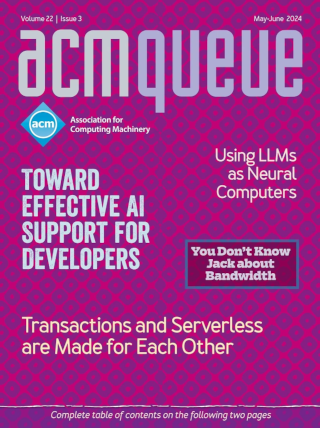A Conversation with Douglas W. Jones and Peter G. Neumann:
Does technology help or hinder election integrity?
Elections form the fundamental basis of all democracies. In light of many past problems with the integrity of election processes around the world, ongoing efforts have sought to increase the use of computers and communications in elections to help automate the process. Unfortunately, many existing computer-related processes are poorly conceived and implemented, introducing new problems related to such issues as voter confidentiality and privacy, computer system integrity, accountability and resolution of irregularities, ease of administration by election officials, and ease of use by voters—with many special problems for those with various handicaps. Overall, the issues relating to computer security provide a representative cross-section of the difficulties inherent in attempting to develop and operate trustworthy systems for other applications.
Understanding DRM:
Recognizing the tradeoffs associated with different DRM systems can pave the way for a more flexible and capable DRM.
The explosive growth of the Internet and digital media has created both tremendous opportunities and new threats for content creators. Advances in digital technology offer new ways of marketing, disseminating, interacting with, and monetizing creative works, giving rise to expanding markets that did not exist just a few years ago. At the same time, however, the technologies have created major challenges for copyright holders seeking to control the distribution of their works and protect against piracy.
Four Billion Little Brothers? Privacy, mobile phones, and ubiquitous data collection:
Participatory sensing technologies could improve our lives and our communities, but at what cost to our privacy?
They place calls, surf the Internet, and there are close to 4 billion of them in the world. Their built-in microphones, cameras, and location awareness can collect images, sound, and GPS data. Beyond chatting and texting, these features could make phones ubiquitous, familiar tools for quantifying personal patterns and habits. They could also be platforms for thousands to document a neighborhood, gather evidence to make a case, or study mobility and health. This data could help you understand your daily carbon footprint, exposure to air pollution, exercise habits, and frequency of interactions with family and friends.
Communications Surveillance: Privacy and Security at Risk:
As the sophistication of wiretapping technology grows, so too do the risks it poses to our privacy and security.
We all know the scene: It is the basement of an apartment building and the lights are dim. The man is wearing a trench coat and a fedora pulled down low to hide his face. Between the hat and the coat we see headphones, and he appears to be listening intently to the output of a set of alligator clips attached to a phone line. He is a detective eavesdropping on a suspect’s phone calls. This is wiretapping. It doesn’t have much to do with modern electronic eavesdropping, which is about bits, packets, switches, and routers.
A Threat Analysis of RFID Passports:
Do RFID passports make us vulnerable to identity theft?
It’s a beautiful day when your plane touches down at the airport. After a long vacation, you feel rejuvenated, refreshed, and relaxed. When you get home, everything is how you left it. Everything, that is, but a pile of envelopes on the floor that jammed the door as you tried to swing it open. You notice a blinking light on your answering machine and realize you’ve missed dozens of messages. As you click on the machine and pick up the envelopes, you find that most of the messages and letters are from debt collectors. Most of the envelopes are stamped "urgent," and as you sift through the pile you can hear the messages from angry creditors demanding that you call them immediately.
The Software Industry IS the Problem:
The time has come for software liability laws.
One score and seven years ago, Ken Thompson brought forth a new problem, conceived by thinking, and dedicated to the proposition that those who trusted computers were in deep trouble. I am, of course, talking about Thompson’s Turing Award lecture, "Reflections on Trusting Trust." Unless you remember this piece by heart, you might want to take a moment to read it if at all possible.
More Encryption Is Not the Solution:
Cryptography as privacy works only if both ends work at it in good faith.
The recent exposure of the dragnet-style surveillance of Internet traffic has provoked a number of responses that are variations of the general formula, "More encryption is the solution." This is not the case. In fact, more encryption will probably only make the privacy crisis worse than it already is.
How to De-identify Your Data:
Balancing statistical accuracy and subject privacy in large social-science data sets
Big data is all the rage; using large data sets promises to give us new insights into questions that have been difficult or impossible to answer in the past. This is especially true in fields such as medicine and the social sciences, where large amounts of data can be gathered and mined to find insightful relationships among variables. Data in such fields involves humans, however, and thus raises issues of privacy that are not faced by fields such as physics or astronomy.
Accountability in Algorithmic Decision-making:
A view from computational journalism
Every fiscal quarter automated writing algorithms churn out thousands of corporate earnings articles for the AP (Associated Press) based on little more than structured data. Companies such as Automated Insights, which produces the articles for AP, and Narrative Science can now write straight news articles in almost any domain that has clean and well-structured data: finance, sure, but also sports, weather, and education, among others. The articles aren’t cardboard either; they have variability, tone, and style, and in some cases readers even have difficulty distinguishing the machine-produced articles from human-written ones.
More Encryption Means Less Privacy:
Retaining electronic privacy requires more political engagement.
When Edward Snowden made it known to the world that pretty much all traffic on the Internet was collected and searched by the NSA, GCHQ (the UK Government Communications Headquarters) and various other countries’ secret services as well, the IT and networking communities were furious and felt betrayed.
Pervasive, Dynamic Authentication of Physical Items:
The use of silicon PUF circuits
Authentication of physical items is an age-old problem. Common approaches include the use of bar codes, QR codes, holograms, and RFID (radio-frequency identification) tags. Traditional RFID tags and bar codes use a public identifier as a means of authenticating. A public identifier, however, is static: it is the same each time when queried and can be easily copied by an adversary. Holograms can also be viewed as public identifiers: a knowledgeable verifier knows all the attributes to inspect visually. It is difficult to make hologram-based authentication pervasive; a casual verifier does not know all the attributes to look for.
Access Controls and Health Care Records: Who Owns the Data?:
A discussion with David Evans, Richard McDonald, and Terry Coatta
What if health care records were handled in more of a patient-centric manner, using systems and networks that allow data to be readily shared by all the physicians, clinics, hospitals, and pharmacies a person might choose to share them with or have occasion to visit? And, more radically, what if it was the patients who owned the data?
Hack for Hire:
Investigating the emerging black market of retail email account hacking services
Hack-for-hire services charging $100-$400 per contract were found to produce sophisticated, persistent, and personalized attacks that were able to bypass 2FA via phishing. The demand for these services, however, appears to be limited to a niche market, as evidenced by the small number of discoverable services, an even smaller number of successful services, and the fact that these attackers target only about one in a million Google users.
The Identity in Everyone's Pocket:
Keeping users secure through their smartphones
Newer phones use security features in many different ways and combinations. As with any security technology, however, using a feature incorrectly can create a false sense of security. As such, many app developers and service providers today do not use any of the secure identity-management facilities that modern phones offer. For those of you who fall into this camp, this article is meant to leave you with ideas about how to bring a hardware-backed and biometrics-based concept of user identity into your ecosystem.
Differential Privacy: The Pursuit of Protections by Default:
A discussion with Miguel Guevara, Damien Desfontaines, Jim Waldo, and Terry Coatta
First formalized in 2006, differential privacy is an approach based on a mathematically rigorous definition of privacy that allows formalization and proof of the guarantees against re-identification offered by a system. While differential privacy has been accepted by theorists for some time, its implementation has turned out to be subtle and tricky, with practical applications only now starting to become available. To date, differential privacy has been adopted by the U.S. Census Bureau, along with a number of technology companies, but what this means and how these organizations have implemented their systems remains a mystery to many.
Toward Confidential Cloud Computing:
Extending hardware-enforced cryptographic protection to data while in use
Although largely driven by economies of scale, the development of the modern cloud also enables increased security. Large data centers provide aggregate availability, reliability, and security assurances. The operational cost of ensuring that operating systems, databases, and other services have secure configurations can be amortized among all tenants, allowing the cloud provider to employ experts who are responsible for security; this is often unfeasible for smaller businesses, where the role of systems administrator is often conflated with many others.
Federated Learning and Privacy:
Building privacy-preserving systems for machine learning and data science on decentralized data
Centralized data collection can expose individuals to privacy risks and organizations to legal risks if data is not properly managed. Federated learning is a machine learning setting where multiple entities collaborate in solving a machine learning problem, under the coordination of a central server or service provider. Each client's raw data is stored locally and not exchanged or transferred; instead, focused updates intended for immediate aggregation are used to achieve the learning objective.
Surveillance Too Cheap to Meter:
Stopping Big Brother would require an expensive overhaul of the entire system.
IT nerds tend to find technological solutions for all sorts of problems?economic, political, sociological, and so on. Most of the time, these solutions don't make the problems that much worse, but when a problem is of a purely economic nature, only solutions that affect the economics of the situation can possibly work. Neither cryptography nor smart programming will be able to move the needle even a little bit when the fundamental problem is that surveillance is too cheap to meter.
Privacy of Personal Information:
Going incog in a goldfish bowl
Each online interaction with an external service creates data about the user that is digitally recorded and stored. These external services may be credit card transactions, medical consultations, census data collection, voter registration, etc. Although the data is ostensibly collected to provide citizens with better services, the privacy of the individual is inevitably put at risk. With the growing reach of the Internet and the volume of data being generated, data protection and, specifically, preserving the privacy of individuals, have become particularly important.
CSRB's Opus One:
Comments on the Cyber Safety Review Board Log4j Event Report
We in FOSS need to become much better at documenting design decisions in a way and a place where the right people will find it, read it, and understand it, before they do something ill-advised or downright stupid with our code.
Mapping the Privacy Landscape for Central Bank Digital Currencies:
Now is the time to shape what future payment flows will reveal about you.
As central banks all over the world move to digitize cash, the issue of privacy needs to move to the forefront. The path taken may depend on the needs of each stakeholder group: privacy-conscious users, data holders, and law enforcement.
Improvement on End-to-End Encryption May Lead to Silent Revolution:
Researchers are on a brink of what could be the next big improvement in communication privacy.
Privacy is an increasing concern, whether you are texting with a business associate or transmitting volumes of data over the Internet. Over the past few decades, cryptographic techniques have enabled privacy improvements in chat apps and other electronic forms of communication. Now researchers are on the brink of what could be the next big improvement in communication privacy: E2EEEE (End-to-End Encryption with Endpoint Elimination). This article is based on interviews with researchers who plan on presenting at a symposium on the topic scheduled for April 1, 2023.
Don't "Think of the Internet!":
No human right is absolute.
I cannot help but notice few women subscribe to absolutist views of electronic privacy and anonymity. Can it be that only people who play life on the easiest setting find unrestricted privacy and anonymity a great idea?
Multiparty Computation: To Secure Privacy, Do the Math:
A discussion with Nigel Smart, Joshua W. Baron, Sanjay Saravanan, Jordan Brandt, and Atefeh Mashatan
Multiparty Computation is based on complex math, and over the past decade, MPC has been harnessed as one of the most powerful tools available for the protection of sensitive data. MPC now serves as the basis for protocols that let a set of parties interact and compute on a pool of private inputs without revealing any of the data contained within those inputs. In the end, only the results are revealed. The implications of this can often prove profound.
From Open Access to Guarded Trust:
Experimenting responsibly in the age of data privacy
The last decade witnessed the emergence and strengthening of data protection regulations. For software engineers, this new era poses a unique challenge: How do you maintain the precision and efficacy of your platforms when complete data access, one of your most potent tools, is gradually being taken off the table? The mission is clear: Reinvent the toolkit. The way we perceive, handle, and experiment with data needs a drastic overhaul to navigate this brave new world.
A "Perspectival" Mirror of the Elephant:
Investigating language bias on Google, ChatGPT, YouTube, and Wikipedia
Many people turn to Internet-based, software platforms such as Google, YouTube, Wikipedia, and more recently ChatGPT to find the answers to their questions. Most people tend to trust Google Search when it states that its mission is to deliver information from "many angles so you can form your own understanding of the world." Yet, our work finds that queries involving complex topics yield results focused on a narrow set of culturally dominant views, and these views are correlated with the language used in the search phrase. We call this phenomenon language bias, and this article shows how it occurs using the example of two complex topics: Buddhism and liberalism.






